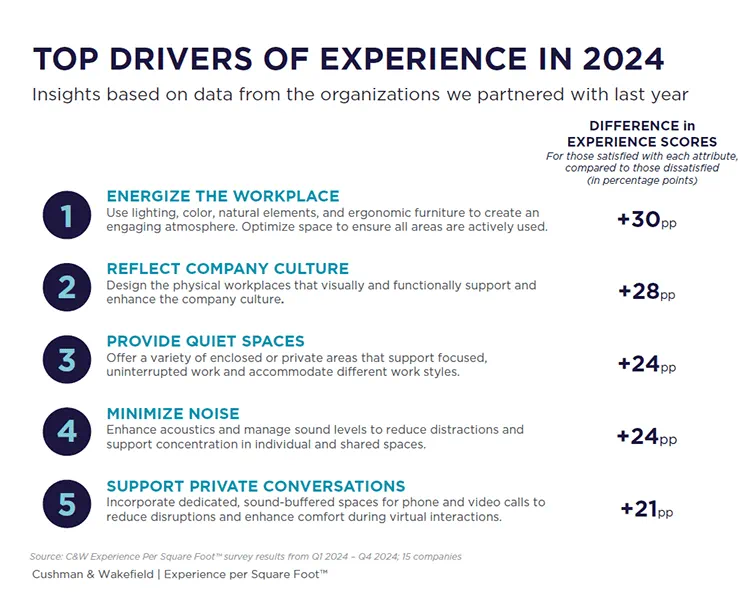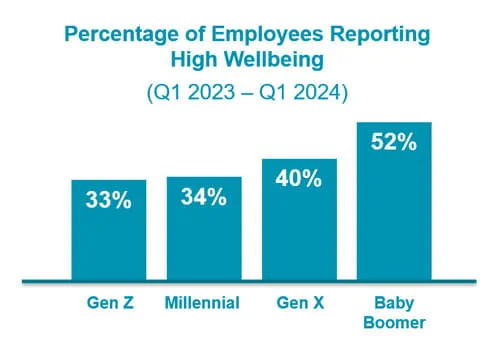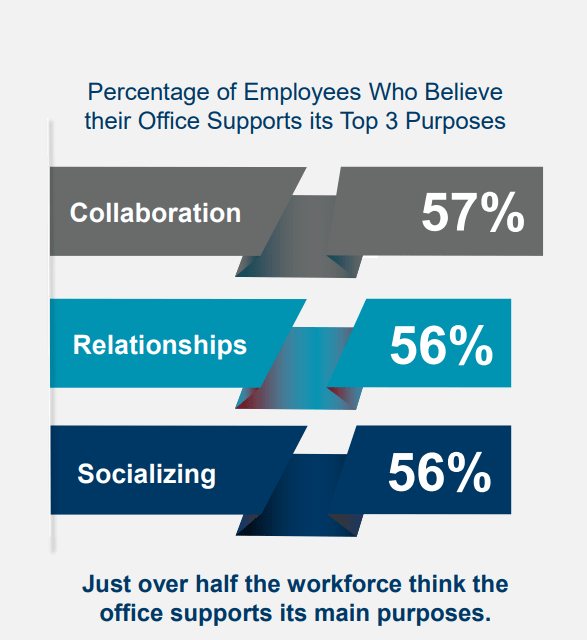

Experience per Square FootTM Instant Insights
Welcome to our monthly Experience per Square FootTM Insight page. The goal of our Total Workplace Research & Innovation Team is to keep you informed about the latest trends in the dynamic commercial real estate industry. Each month, we will present our own insights and in-depth examination of emerging shifts that can help you make informed real estate decisions.
INSIGHTS IN YOUR INBOX
Subscribe to get our latest research and insight from Cushman & Wakefield’s Experience per Square Foot™ delivered to your inbox.
April 2025

Our Data-Driven Approach
To uncover what drives better workplace experience, we:
- Analyzed data from 6,000+ employees across 15 organizations in 2024
- Used regression to identify which of 35 workplace features matter most
- Quantified where improvements would yield the greatest returns
Key Findings: Satisfaction with top-impact features was low-none exceeded 62%, with an average of just 48%. This presents a big opportunity for targeted improvements.
These insights shaped our list of the Top 5 Workplace Investments for 2025 - not as a one-size-fits-all checklist, but as a practical starting point for making smarter, evidence-based decisions tailored to your organization's unique needs.
Read more in the April 2025 XSF Instant Insight.
Source: C&W Experience Per Square Foot survey results from Q1 2024 – Q4 2024; 15 companies
Dec 2024
More than a nuisance: Long commutes are linked to lower productivity for office regulars
Significant differences in Best Work, Team, and Focus scores drive the dip in Productivity for office regulars with long commutes.
Read more in the December XSF Instant Insight.
Source: C&W Occupier Experience Survey powered by Experience Per Square Foot results from Q1 2023 – Q4 2023; Purpose of Office n = 7,389 ; Supports Office Purpose n = 6,914.
Sept 2024

The Evolution of Remote Work Trends in Office-Using Industries
Remote work job postings surged to unprecedented levels during COVID-19, but we're now seeing an overall decline. However, the picture varies significantly across industries. The shift to remote work remains a major factor, though the extent and impact differ by industry.
This report explores current trends in remote job postings across key industries in the United States, highlighting notable variations. Moving forward, it's crucial to monitor these trends closely. Key questions remain: Will industries align in their downward trends? And how far will remote job postings fall?
Read more in the September XSF Instant Insight.
Source: LightCast job postings data for office-using, full-time, remote employees in the US from January 2019 to August 2024. Cushman & Wakefield
July 2024

Top 10 Building Amenities
In response to evolving market dynamics, companies and building owners are reassessing their approach to building amenities. Offering the most valued amenities for employees is essential for attracting and retaining top talent, which is in turn essential for securing and retaining top clients in a competitive office market.
We surveyed 1,100+ employees across 122 companies in six U.S. office buildings, asking them to rank 30 building amenities.
Read more in the July XSF Instant Insight.
Source: C&W Tenant Experience Survey powered by Experience Per Square Foot™ results from Q1 2023 – Q2 2024; n = 1,131 representing 122 tenants across 6 buildings. Statistical analysis used to measure employee preference for 30 building amenities.
May 2024

A Generational Approach to Improve Wellbeing
Wellbeing levels have experienced a precipitous drop since 2019 and have yet to recover. While all generations struggle, our youngest generations struggle the most. In this report, we delve into the primary drivers of wellbeing for each generation, highlighting both commonalities and critical differences. This understanding lays the groundwork for a targeted approach to enhance wellbeing across age cohorts.
Read more in the May XSF Instant Insight.
April 2024

The Purpose-Driven Office
As the evolution of work shifts towards a blend of office, home, and alternate spaces, the role of the office has transformed too. Rather than serving as the one place where we once completed all our tasks, employees have highlighted the importance of the office as a hub for fostering community and connection.
According to employees, the main purposes of the office include facilitating collaboration, nurturing relationships, and promoting social interactions.
Read more in the April XSF Instant Insight.
Feb 2024
The Productivity Fall of 2023
 Throughout the pandemic, we reported that employee productivity was maintained. But in 2023, productivity dropped 13 percentage points. The XSF Productivity Index is comprised of three components: Focus, Team, and Best Work. Each component declined from 2022 to 2023. The top 5 drivers of productivity—Inspiration, Energy, Learning, Belonging, and Cultural Connection—all dropped in 2023, with fewer than 50% of people reporting a positive experience for all drivers except Learning. Of the four drivers with less than half of people reporting a positive experience, only Energy was already below 50% before 2023.
Throughout the pandemic, we reported that employee productivity was maintained. But in 2023, productivity dropped 13 percentage points. The XSF Productivity Index is comprised of three components: Focus, Team, and Best Work. Each component declined from 2022 to 2023. The top 5 drivers of productivity—Inspiration, Energy, Learning, Belonging, and Cultural Connection—all dropped in 2023, with fewer than 50% of people reporting a positive experience for all drivers except Learning. Of the four drivers with less than half of people reporting a positive experience, only Energy was already below 50% before 2023.
Read more in the February XSF Instant Insight.
Previous Editions
Employee Experience Investment Guide
 Many factors influence employee experience at a company including benefits, culture, manager quality, and senior leadership behavior. Beyond these factors, employers have an additional and powerful way to influence employee experience - the workplace. The challenge companies face is knowing exactly how to invest in the workplace to boost experience.
Many factors influence employee experience at a company including benefits, culture, manager quality, and senior leadership behavior. Beyond these factors, employers have an additional and powerful way to influence employee experience - the workplace. The challenge companies face is knowing exactly how to invest in the workplace to boost experience.
To address this challenge, we used regression analysis to evaluate 30 features of the workplace environment to uncover how effectively they each drive experience.
Read more in the January XSF Instant Insight.
OCTOBER 2023
What Drives Regular Office Attendance?
|
 |
Read more in the October XSF Instant Insight.
SEPTEMBER 2023
The Impact of Office Attendance
 Productivity is top-of-mind for many leaders in today’s market conditions and employee office attendance has long been considered a key factor in driving productivity. The prevailing belief is that those who consistently go to the office are going to be more productive than those who don’t.
Productivity is top-of-mind for many leaders in today’s market conditions and employee office attendance has long been considered a key factor in driving productivity. The prevailing belief is that those who consistently go to the office are going to be more productive than those who don’t.
This report reveals that “fixing” office attendance will not guarantee productivity, but there are other factors that can improve it. Focusing on these aspects of work will yield a higher ROI on productivity than a focus on office attendance.
AUGUST 2023
The Impact of Mandates
 About one-third (34%) of employees who cannot choose where to work come into the office 3+ days/week, compared to only 20% of those who can choose. When comparing the choice and no choice group, this 14 percentage-point difference in primarily in-office employees comes from a 5 percentage-point difference in hybrid workers and a 9 percentage-point difference in primarily remote workers.
About one-third (34%) of employees who cannot choose where to work come into the office 3+ days/week, compared to only 20% of those who can choose. When comparing the choice and no choice group, this 14 percentage-point difference in primarily in-office employees comes from a 5 percentage-point difference in hybrid workers and a 9 percentage-point difference in primarily remote workers.
- Limiting employees’ location flexibility and choice through mandates can increase office attendance.
- However, employees’ engagement and ability to do their best work may suffer.
- Is the short-term attendance gain driven by mandates worth the potential impact to engagement?



